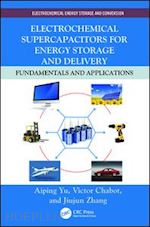Aiping Yu is an assistant professor at the University of Waterloo in Canada. She earned her PhD from the University of California– Riverside. Her research interests are materials and modeling development for energy storage and conversion, photocatalysts, and nanocomposites. Dr. Yu has published over 35 papers in peer-reviewed journals such as Science and one book chapter relating to supercapacitors. She currently is the editorial member of the Nature: Scientific Reports. Her work has been featured by major media such as Nature: Nanotechnology, Photonics.com, and Azonano.com. Her patent for graphene nanomaterials has been licensed to a company in San Jose. Victor Chabot received his bachelor's degree in nanoengineering from the University of Waterloo and currently is pursuing his graduate degree in chemical engineering at the University of Waterloo. His research focuses on nanomaterial development for high energy density supercapacitors. Jiujun Zhang is a principal research officer and technical leader at the National Research Council of Canada’s Institute for Fuel Cell Innovation (NRC-IFCI), now the council's Energy, Mining, and Environment (NRC-EME) portfolio. Dr. Zhang earned a BS and MSc in electrochemistry from Peking University in 1982 and 1985, respectively, and a PhD in electrochemistry from Wuhan University in 1988. After completing his doctorate, he took a position as an associate professor at the Huazhong Normal University for 2 years. Starting in 1990, he carried out three terms of postdoctoral research at the California Institute of Technology, York University, and the University of British Columbia. Dr. Zhang has over 28 years of research and development experience in theoretical and applied electrochemistry, 14 of which were spent working on fuel cells at Ballard Power Systems and at NRC-IFCI. He also spent 3 years researching electrochemical sensors. Dr. Zhang holds adjunct professorships at the University of Waterloo, the University of British Columbia, and at Peking University. To date, Dr. Zhang has co-authored or edited more than 300 publications including 190 refereed journal papers with approximately 4,700 citations, books, conference proceeding papers, book chapters, and 50 conference and invited oral presentations. He also holds over 10 patents worldwide along with 9 U.S. patent publications and has produced more than 80 industrial technical reports. Dr. Zhang serves as an editor or editorial board member for several international journals and is also the editor for CRC's Electrochemical Energy Storage and Conversion series of books. Dr. Zhang is an active member of the Electrochemical Society, the International Society of Electrochemistry and the American Chemical Society.











